Bell UH-1 Iroquois Helicopter

The Bell UH-1 Iroquois Helicopter, nicknamed the “Huey,” was built in 1959 for the United States Army by Bell Corporation. Originally known as the Bell HU-1, it was designed to be a utility helicopter, primarily used for personnel transport and, later, MEDEVAC operations during the Vietnam War. When unveiled in 1960, the HU-1 set seven world records, including longest non-stop flight, speed, and speed climbing. After many variations, the UH-1 Iroquois was officially retired by the U.S. Army in 2011. The Air Force still uses the UH-1N while it determines its replacement.

Longevity:
The UH-1 military helicopter has the legacy of being the longest used and manufactured helicopter in the United States military. Originally created for the U.S. Army in 1959, multiple variations of the aircraft have been created by Bell Corporation for the differing needs of each branch.

The Huey:
Even though the formal name for the original model was the Iroquois, it was nicknamed the “Huey” due to the original HU-1 Army designation it was afforded. In 1962, the Army officially changed its designator to the UH-1. However, the nickname continued until the retirement of the UH-1. The United States Air Force and United States Marine Corp. also adopted this nickname when their versions were delivered in 1964.
The UH-1H:
The most recent variation of the Huey used by the United States Army was the UH-1H. In addition to the original specifications of the aircraft, the UH-1H was powered by a T53-L-13B engine, with a take off of 1,100 shp and a horsepower capacity of 1,400 shp. In terms of performance, the UH-1H can reach a maximum speed of 120 knots, a cruise speed of 112 knots, and a climb range of 1,600 feet per minute. It caps out at a service height of 12,600 feet.

Breaking Records:
The Huey flown by Army pilots in 1960 broke seven world records held by other helicopters up until that point. It broke the record for longest distance traveled at 441.74 miles, exceeding its expected distance in regards to fuel capacity. In addition, it recorded three speed records and two speed climbing records. The HU-1 reached a height of 10,000 feet in less than four minutes, and 24,250 feet in less than twelve minutes.
A Global Helicopter:

In the Air Force, the UH-1H keeps a designator of UH-1N, even though the specifications on the helicopter are similar. In addition to the US Air Force, other countries also use variants of the UH-1H. In Germany, the UH-1D is known as the Dronier. The Japanese fly the HU-1H nicknamed the Fuji-Bell. In Italy, the designation is an AB 205A donning the name of the Agusta-Bell. Canada’s version is known as the CH-118. While the designator and nicknames vary from country, or even within branches, the Huey is a commonly used helicopter by various allies of the United States.
Well Deserved Retirement:
The Army officially retired the UH-1H Iroquois “Huey” helicopter in 2011, phased out in favor of the UH-60 “Blackhawk” helicopter after roughly 50 years of service. Through the years, it was used for command and control operations, search and rescue, resupply, MEDEVAC, troop and civilian transport, and reconnaissance.

Fort Rucker, the home of the aviation branch of the Army, retired the use of the UH-1 from service. During the retirement, one speech-giver noted that over 15 million sorties were flown by Hueys during Vietnam alone. On August 4th, 2011, commanders from the Joint Readiness Training Center (JRTC) took one final jump out of a Huey to note its retirement from use at JRTC.
While the UH-1N has not been retired by the Air Force, plans are in the works to decommission the use of it by 2020. The Bell UH-1 Iroquois “Huey” helicopter is one the most utilized and recognized helicopters of armed forces around the world.
Now see more powerful images of the Huey helicopter.
See UH-1 Specifications
| Primary Function: Utility helicopter |
| Manufacturer: Bell Helicopter Trexon |
| Power Plant: Pratt and Whitney T400-CP-400 |
| Power (Burst): 1290 shaft horsepower (transmission limited) |
| Power (Continuous): 1134 shaft horsepower (transmission limited) |
| Length: 57.3 feet (17.46 meters) |
| Height: 14.9 feet (4.54 meters) |
| Rotor Diameter: 48 feet (14.62 meters) |
| Speed: 121 knots (139.15 miles per hour) at sea level |
| Ceiling: 14,200 feet (4331 meters) (limited to 10,000 feet (3050 meters) by oxygen requirements) |
| Max. Takeoff Weight: 10,500 pounds (4,767 kilograms) |
| Range: 172 nautical miles (197.8 miles) |
| Crew: Officer – 2; Enlisted – 2 |
| Armament: M240D 7.62mm machine gun or GAU-16/A .50 caliber machine gun or GAU-17/A 7.62mm automatic gun. All three weapons systems are crew-served, and depending on the subsystem used the GAU-17/A can also be controlled by the pilot in a fixed forward firing mode. The helicopter can also carry two 7-shot or 19-shot 2.75″ rocket pods. |
| Introduction Date: 1971 |
| Unit Replacement Cost: $4,700,000 |

